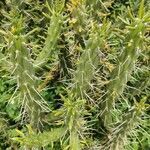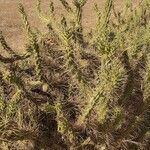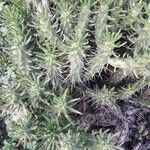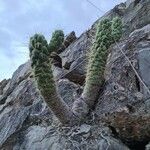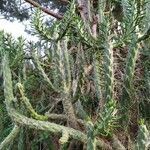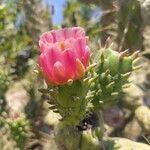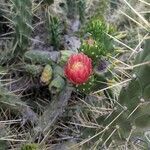Much-branched spreading shrubs forming thickets, developing a trunk with age. Joints arcuate, cylindrical, tuberculate, c. 3 cm in diam., glaucous-green. Leaves linear to terete, 3-6 (-12) cm long, arcuate, fleshy, persistent. Areoles with a protruding white woolly pubescence; with 1 or 2 acicular, straight, strong yellow-brown spines up to 5 cm long. Flowers with the hypanthium forming a reduced apical spineless joint which in turn may proliferate; petaloid segments 2-3 cm long, orange or greenish yellow. Fruit not seen in South African material. ('Green, pear-shaped, 9 cm long, usually sterile; seeds large, irregular, 10 mm broad' fide Britton & Rose).
Much-branched shrub, 2-4 m high. Branches cylindrical, up to 0.5 m long, green or somewhat glaucous; tubercles in a few spirals, sharply defined, vertically rhomboid to decurrent-obovate; spines (1)2-4, strong, straight, up to 80(-130) mm long. Leaves subulate, persistent, with areoles at upper extremities of tubercles. Perianth not widely flaring, 1/3 of flower length; tepals scarlet, orange or yellowish. Fruit elongate, obovoid-oblong to clavate or ± spherical, ± spiny, sometimes successively proliferous (mostly sterile in SA). Seeds (1-)19, globose or isodiametric, 8-10 mm in diam.
Shrub, up to 5 m high; cladodes cylindrical; tuberculate; glaucous green; areoles white woolly. Spines 1-4, strong, straight, up to 80 mm long, greyish white, white or yellowish brown when young. Leaves linear, 30-60 mm long, curved, fleshy, persistent. Flowers: 60-70 mm long; floral tube relatively long, tuberculate, with porrect, subulate bract scales resembling small leaves. perianth 1/3 of flower length; perianth segments 20-30 mm long, scarlet, orange or yellowish. Fruit elongate, obovoid-oblong to clavate or ± spherical, > 50 mm long, ± spiny.
An erect cactus. It is treelike. It grows 2-4 m high. The stems are 6-10 cm thick and branching. The stems and joints have lumps over them. The leaves on the upper stem are like half cylinders. These are 10 cm long. There are 1 or 2 pale yellow spines up to 8 cm long in a spine spot. The flowers are reddish. They are 2 cm wide. The fruit are oval and 10 cm long.
